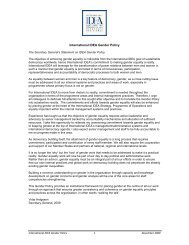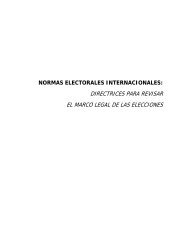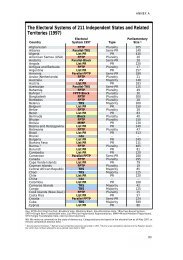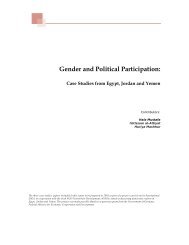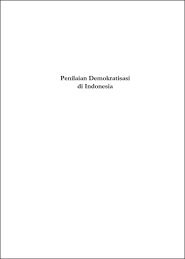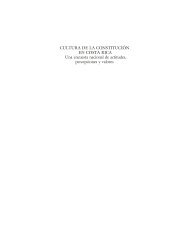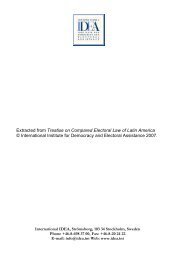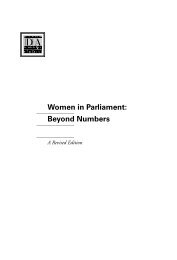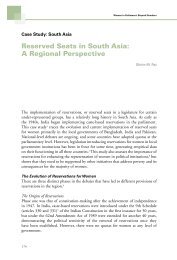The Role of State Constitutions in Protecting ... - International IDEA
The Role of State Constitutions in Protecting ... - International IDEA
The Role of State Constitutions in Protecting ... - International IDEA
Create successful ePaper yourself
Turn your PDF publications into a flip-book with our unique Google optimized e-Paper software.
m<strong>in</strong>ority rights. <strong>The</strong> Australian federation is an exception, which has been able to<br />
cont<strong>in</strong>ue only because each <strong>State</strong> <strong>in</strong> fact has broadly common standards, and there<br />
has so far been no cause for real concern.<br />
Division <strong>of</strong> power<br />
<strong>The</strong> federal division <strong>of</strong> power is set out <strong>in</strong> the Commonwealth Constitution. <strong>The</strong><br />
pr<strong>in</strong>ciple on which the framers <strong>of</strong> that Constitution worked was as follows. Each<br />
colony, soon to become a <strong>State</strong>, already had full powers <strong>of</strong> self-government,<br />
with<strong>in</strong> its own territory. In order to establish a federation, the <strong>State</strong>s must lose<br />
some powers to the new national government, the Commonwealth. Only the<br />
powers that were considered necessary for the Commonwealth, however, should<br />
be transferred <strong>in</strong> this way. This pr<strong>in</strong>ciple was given effect both <strong>in</strong> the model for<br />
the division <strong>of</strong> powers between the Commonwealth and the <strong>State</strong>s and <strong>in</strong> the<br />
particular powers that were conferred on the Commonwealth.<br />
Model for the division <strong>of</strong> powers<br />
Powers are divided under the Australian Constitution by giv<strong>in</strong>g particular powers<br />
to the Commonwealth and leav<strong>in</strong>g the rema<strong>in</strong>der with the <strong>State</strong>s. Most <strong>of</strong> the<br />
Commonwealth powers are “concurrent”. This means that the <strong>State</strong>s can exercise<br />
them as well, although if there is a conflict between a Commonwealth and a <strong>State</strong><br />
law, the Commonwealth law will prevail and the <strong>State</strong> law will be “<strong>in</strong>operative”.<br />
A few Commonwealth powers are “exclusive”, <strong>in</strong>clud<strong>in</strong>g power to impose duties<br />
<strong>of</strong> customs and excise. <strong>The</strong> <strong>State</strong>s may not legislate at all <strong>in</strong> relation to<br />
Commonwealth exclusive powers.<br />
<strong>The</strong> Australian federal model divides executive and judicial power between the<br />
Commonwealth and the <strong>State</strong>s as well, <strong>in</strong> a way that broadly matches the division<br />
<strong>of</strong> legislative power. In this respect Australia (and most <strong>of</strong> the other common law<br />
federations) is different to the German federal model, where the <strong>State</strong>s have more<br />
adm<strong>in</strong>istrative than legislative power. This approach is also reflected <strong>in</strong> the <strong>in</strong>stitutional<br />
structure <strong>of</strong> government. With a few exceptions, there is a complete set<br />
<strong>of</strong> govern<strong>in</strong>g <strong>in</strong>stitutions at the national level and with<strong>in</strong> each <strong>State</strong>, to exercise<br />
these various powers.<br />
Thus each <strong>State</strong> has a Parliament, an executive government with a Governor<br />
represent<strong>in</strong>g the Queen, and a court system. Other <strong>in</strong>stitutions are duplicated as<br />
well, <strong>in</strong>clud<strong>in</strong>g Auditors-General and Ombudsmen. Similarly, the<br />
Commonwealth has a Parliament, executive government and Governor-General<br />
and court system; although the highest Commonwealth court, the High Court <strong>of</strong><br />
Australia, also acts as the f<strong>in</strong>al court <strong>of</strong> appeal from all <strong>State</strong> courts and <strong>State</strong><br />
courts can exercise federal judicial power. Some <strong>in</strong>stitutions are found only at the<br />
Commonwealth level, because they fall with<strong>in</strong> Commonwealth power, or have<br />
been established by co-operation between governments. <strong>The</strong> Reserve Bank <strong>of</strong><br />
Australia, the Australian Competition and Consumer Commission and the<br />
Australian Corporations and Investment Commission are examples.<br />
35




